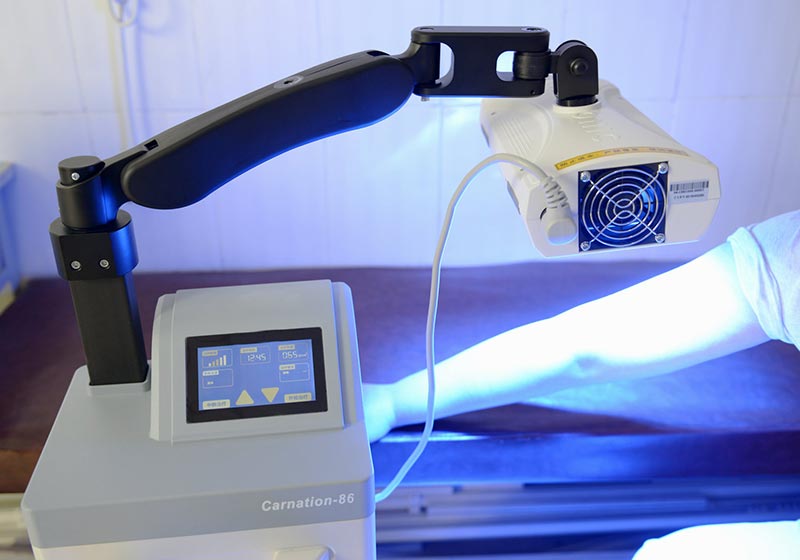Semiconductor laser therapy instrument is a device for medical treatment and rehabilitation using semiconductor laser technology. The following is a detailed introduction to the semiconductor laser therapy instrument:

Categories:
1.Handheld semiconductor laser therapy instrument: portable, easy to control, suitable for personal care and home use.
2.Bedside semiconductor laser therapy instrument: designed for bedside or clinical use, with richer features and treatment options.
Electrical index:
1.Output power: Usually in milliwatts (mW) as a unit, indicating the output power of the laser treatment instrument. Depending on the device design and treatment needs, the value can range from a few milliwatts to tens of watts.
2.Wavelength: The wavelength selection of semiconductor laser therapy instrument is based on application needs and treatment objectives. Common wavelength ranges include low-energy infrared wavelengths (e.g. 650 nm, 808 nm) and near-infrared wavelengths (e.g. 904 nm), which have good biostimulatory effects.
3.Pulse frequency: refers to the frequency of laser pulse emission, generally in Hertz (Hz). The setting of the pulse frequency can be adjusted according to treatment needs.
4.Treatment mode: Semiconductor laser therapy instrument may support different treatment modes, such as continuous wave mode, pulse mode, etc. The choice of treatment mode can be determined according to the specific application and clinical needs.
5.Other functions: Some semiconductor laser therapy devices may have other functions, such as adjustable treatment time, multiple power level options, preset treatment plans, etc. These features can provide more treatment options and personalization.

Please note that the above electrical indicators may vary between products. Specific electrical indicators should refer to the specific product specification sheet or contact the manufacturer for accurate and up-to-date information.
Product features:
1.Non-invasive treatment: Using low-energy lasers, no incisions or injections, very patient friendly.
2.Precise irradiation: It has adjustable laser output power and wavelength to carry out precise treatment for different conditions and parts.
3.Fast results: Semiconductor laser therapy can provide rapid pain relief, promote tissue repair and rehabilitation effects.
4.Safe and reliable: in line with medical device standards, through strict testing and certification, to ensure product safety and reliability.
5.Easy to use: the operation is simple, you can choose the preset treatment mode according to your needs, and it has an intuitive human-machine interface.
Scope of application:
1.Pain management: For the relief of pain conditions, such as arthritis, muscle pain, nerve pain, etc.
2.Sports rehabilitation: To help athletes and sports injuries speed up rehabilitation and recovery, relieve exercise-related muscle pain and injury.
3.Skin beauty: used to improve skin problems, such as scars, inflammation, acne, etc., to promote tissue repair and regeneration.
4.Physical therapy: used in rehabilitation centers or medical institutions for muscle injuries, joint diseases and other rehabilitation treatments.
Semiconductor laser therapy devices utilize their unique optical properties and biostimulating effects to provide a safe, non-invasive treatment option for pain management, rehabilitation and beauty. It has been widely used in clinical practice and personal care to provide better health and quality of life for patients.

In the circuit board processing process of semiconductor laser therapy instrument, the following are some matters that need attention:
1.PCB design: Ensure that the circuit board design meets the product requirements and specifications. Given the complexity and accuracy of semiconductor laser therapy devices, PCB design should follow best practices, including correct line width, spacing, layer stacking, ground plane, and signal integrity.
2.Material selection: Select high-quality and reliable materials suitable for medical equipment. Considering the special requirements of semiconductor laser therapy instrument, materials with good insulation properties, stability and anti-interference ability are selected.
3.Component installation: Ensure accuracy and stability during component installation. Use appropriate technology and equipment, such as automated mounters or heat guns, to ensure that components are properly placed and soldered securely.

4.Welding quality control: strictly control the welding process to ensure the quality and reliability of the solder joint. Use appropriate welding processes, such as reflow, wave soldering or hand welding, and perform appropriate welding temperature and time control.
5.Testing and quality control: Strict testing and quality control are carried out in the production process to ensure the performance and reliability of the circuit board. This includes electrical testing, functional testing and quality checks as necessary to verify that the board meets specifications and works properly.
6.EMI/EMC design: Pay attention to the design considerations of electromagnetic interference (EMI) and electromagnetic compatibility (EMC). The shielding and filtering technology is adopted to reduce the electromagnetic interference and improve the anti-interference performance of the system.
7.Temperature management: Considering that the semiconductor laser therapy instrument may work under different environmental conditions, ensure that the circuit board has good heat dissipation performance and temperature management. Arrange radiators, fans, or cooling devices to ensure a stable operating temperature range.
8.Documentation and traceability: Maintain detailed documentation and traceability throughout the entire processing process. Raw material information, component lists, welding process records and test reports are included to track and resolve potential problems.
These precautions can help ensure the smooth processing of the circuit board of the semiconductor laser therapy device, and maximize the quality, reliability and performance of the circuit board. Please note that semiconductor laser therapy devices are medical devices and therefore should comply with relevant regulations and standards during manufacturing and processing.


